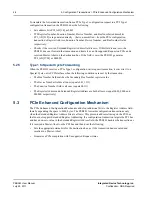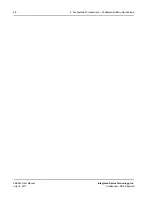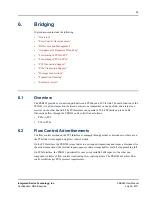
4. Addressing > Non-transparent Addressing
39
PEB383 User Manual
July 25, 2011
Integrated Device Technology, Inc.
Confidential - NDA Required
“NTMA Secondary Lower Base Register”
and
) and NTMA Secondary Limit (see
“NTMA Secondary Lower Limit Register”
“NTMA Secondary Upper Limit Register”
) define memory windows in the PCI bus memory space
that are mapped to arbitrary positions on the PCIe link. The resulting location of the NTMA window on
the PCIe link is defined by the following equations:
•
PriSecNTMADiff = PriNTMABase - SecNTMABase, where
—
PriNTMABase
: Defined by
—
SecNTMABase
: Defined by
“NTMA Secondary Lower Base Register”
and
Secondary Upper Base Register”
.
•
PriNTMALimit = SecNTM PriSecNTMADiff, where
—
SecNTMALimit
: Defined by
“NTMA Secondary Lower Limit Register”
Secondary Upper Limit Register”
.
—
PriSecNTMADiff
: See previous bullet.
A memory cycle whose address falls within a NTMA window on the PCI bus will have its address on
the PCIe link modified by the following equation:
•
PriNTMAAddr = SecNT PriSecNTMADiff, where
—
SecNTMAAddr
:
Secondary NTMA Address, which must fall within the window defined by
the NTMA Secondary Base and Limit registers.
—
PriSecNTMADiff
: See previous bullet.
Transactions that are claimed on PCI Interface, and which are outside the NTMA window, are
forwarded upstream without address remapping. Software should ensure that the location of the NTMA
window on the PCI bus is outside of the PCI bus memory windows, and that the NTMA window on the
PCIe link is outside of the PCIe link memory windows, or undefined operation may result.
displays an example of memory window remapping.






























